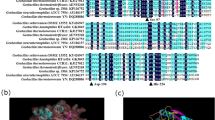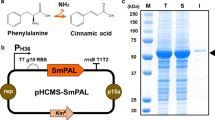Abstract
Cinnamyl acetate has a wide application in food industries. This work focuses on cinnamyl acetate synthesis with a novel esterase. estGUZ753, an esterase gene from Geobacillus uzenensis DSMZ 13551, was first cloned and expressed in Pichia pastoris KM71. The optimal activity of EstGUZ753 towards p-NP caprylate was at pH 8.0 and 70 °C, and the half-life at 70 °C was 28 h. Furthermore, EstGUZ753 showed marked tolerance in methanol. The activity of EstGUZ753 increased up to 1.16-fold in 90% methanol after 72 h, and the half-life in it was 336 h. The crude fermentation broth of EstGUZ753 was immobilized directly onto the epoxy resin (Lx-105s), and the immobilized EstGUZ753 exhibited a 99% conversion for cinnamyl acetate synthesis at a high cinnamyl alcohol concentration in 6 h (cinnamyl alcohol: 1.0 M, enzyme dosage: 3%). These characteristics of EstGUZ753 indicated its great potential for organic synthesis.
Graphic Abstract
A novel esterase gene from Geobacillus uzenensis DSMZ 13551 was first cloned and expressed in Pichia pastoris KM71. Esterase EstGUZ753 showed marked thermostability at high temperature and tolerance in methanol. Furthermore, the crude fermentation broth of EstGUZ753 was immobilized directly onto the epoxy resin, and immobilized EstGUZ753 exhibited a 99% conversion for cinnamyl acetate synthesis.









Similar content being viewed by others
References
Schrader J, Etschmann M, Sell D, Hilmer J-M, Rabenhorst J (2004) Applied biocatalysis for the synthesis of natural flavour compounds–current industrial processes and future prospects. Biotechnol Lett 26(6):463–472
Nenadis N, Wang L-F, Tsimidou M, Zhang H-Y (2004) Estimation of scavenging activity of phenolic compounds using the ABTS•+ assay. J Agric Food Chem 52(15):4669–4674
Devulapelli VG, Weng H-S (2009) Synthesis of cinnamyl acetate by solid–liquid phase transfer catalysis: Kinetic study with a batch reactor. Catal Commun 10(13):1638–1642
Bokade VV, Yadav GD (2009) Transesterification of edible and nonedible vegetable oils with alcohols over heteropolyacids supported on acid-treated clay. Ind Eng Chem Res 48(21):9408–9415
Wang Y, Zhang D-H, Chen N, Zhi G-Y (2015) Synthesis of benzyl cinnamate by enzymatic esterification of cinnamic acid. Bioresour Technol 198:256–261
Geng B, Wang M, Qi W, Su R, He Z (2012) Cinnamyl acetate synthesis by lipase-catalyzed transesterification in a solvent-free system. Biotechnol Appl Biochem 59(4):270–275
Yadav GD, Devendran S (2012) Lipase catalyzed synthesis of cinnamyl acetate via transesterification in non-aqueous medium. Process Biochem 47(3):496–502
Wu Z, Qi W, Wang M, Su R, He Z (2014) Lipase immobilized on novel ceramic supporter with Ni activation for efficient cinnamyl acetate synthesis. J Mol Catal B: Enzym 110:32–38
Kim Y-O, Park I-S, Kim H-K, Nam B-H, Kong HJ, Kim W-J, Kim D-G, Kim B-S, Jee Y-J, Song J-H (2013) Shewanella sp. Ke75 esterase with specificity for p-nitorphenyl butyrate: gene cloning and characterization. J Korean Soc Appl Biol Chem 56(1):55–62
Sharma CK, Chauhan GS, Kanwar SS (2011) Synthesis of medically important ethyl cinnamate ester by porcine pancreatic lipase immobilized on poly (AAc-co-HPMA-cl-EGDMA) hydrogel. J Appl Polym Sci 121(5):2674–2679
Yadav GD, Dhoot SB (2009) Immobilized lipase-catalysed synthesis of cinnamyl laurate in non-aqueous media. J Mol Catal B: Enzym 57(1–4):34–39
Wolfson A, Dlugy C, Karanet A, Tavor D (2012) A sustainable one-pot synthesis of cinnamyl acetate in triacetin. Tetrahedron Lett 53(34):4565–4567
Siddiqui KS, Cavicchioli R (2005) Improved thermal stability and activity in the cold-adapted lipase B from Candida antarctica following chemical modification with oxidized polysaccharides. Extremophiles 9(6):471–476
Trytek M, Jędrzejewski K, Fiedurek J (2015) Bioconversion of α-pinene by a novel cold-adapted fungus Chrysosporium pannorum. J Ind Microbiol Biotechnol 42(2):181–188
Ashjari M, Mohammadi M, Badri R (2015) Chemical amination of Rhizopus oryzae lipase for multipoint covalent immobilization on epoxy-functionalized supports: modulation of stability and selectivity. J Mol Catal B: Enzym 115:128–134
Chen B, Hu J, Miller EM, Xie W, Cai M, Gross RA (2008) Candida antarctica lipase B chemically immobilized on epoxy-activated micro-and nanobeads: catalysts for polyester synthesis. Biomacromol 9(2):463–471
Li C, Tan T, Zhang H, Feng W (2010) Analysis of the conformational stability and activity of Candida antarctica lipase B in organic solvents insight from molecular dynamics and quantum mechanics/simulations. J Biol Chem 285(37):28434–28441
Gouet P, Courcelle E, Stuart DI, Métoz F (1999) ESPript: analysis of multiple sequence alignments in PostScript. Bioinformatics 15(4):305–308
Wang W-f, Li T, Qin X-l, Ning Z-x, Yang B, Wang Y-h (2012) Production of lipase SMG1 and its application in synthesizing diacylglyecrol. J Mol Catal B: Enzym 77:87–91
Fy D, Tang Xd, Yang Xh, Lin L, Dn He, Wei W, Dz W (2019) Immobilization of a novel ESTBAS esterase from Bacillus altitudinis onto an epoxy resin: characterization and regioselective synthesis of chloramphenicol palmitate. Catalysts 9(7):620
Kumar R, Singh R, Kaur J (2014) Combinatorial reshaping of a lipase structure for thermostability: additive role of surface stabilizing single point mutations. Biochem Biophys Res Commun 447(4):626–632
Acharya P, Rajakumara E, Sankaranarayanan R, Rao NM (2004) Structural basis of selection and thermostability of laboratory evolved Bacillus subtilis lipase. J Mol Biol 341(5):1271–1281
Li W, Shi H, Ding H, Wang L, Zhang Y, Li X, Wang F (2018) Characterization of two novel thermostable esterases from Thermoanaerobacterium thermosaccharolyticum protein. Expression Purif 152:64–70
Gao X, Mao X, Lu P, Secundo F, Xue C, Sun J (2019) Cloning, expression, and characterization of a novel thermostable and alkaline-stable esterase from Stenotrophomonas maltophilia OUC_Est10 catalytically active in organic solvents. Catalysts 9(5):401
Sal FA, Colak DN, Guler HI, Canakci S, Belduz AO (2019) Biochemical characterization of a novel thermostable feruloyl esterase from Geobacillus thermoglucosidasius DSM 2542 T. Mol Biol Rep 46(4):4385–4395
Guo Y-Y, Yu X-W, Xu Y (2016) Cloning, expression and characterization of two thermostable esterases from Aquifex aeolicus VF5. J Mol Catal B: Enzym 133:S220–S229
Kim J, Deng L, Hong E, Ryu Y (2015) Cloning and characterization of a novel thermostable esterase from Bacillus gelatini KACC 12197. Protein Expr Purif 116:90–97
Alvarez-Macarie E, Augier-Magro V, Baratti J (1999) Characterization of a thermostable esterase activity from the moderate thermophile Bacillus licheniformis. Biosci Biotechnol Biochem 63(11):1865–1870
Kademi A, Aı̈t-Abdelkader N, Fakhreddine L, Baratti JC (2000) Characterization of a new thermostable esterase from the moderate thermophilic bacterium Bacillus circulans. J Mol Catal B: Enzym 10(4):395–401
Dror A, Shemesh E, Dayan N, Fishman A (2014) Protein engineering by random mutagenesis and structure-guided consensus of Geobacillus stearothermophilus lipase T6 for enhanced stability in methanol. Appl Environ Microbiol 80(4):1515–1527
Cao H, Nie K, Xu H, Xiong X, Krastev R, Wang F, Tan T, Liu L (2016) Insight into the mechanism behind the activation phenomenon of lipase from Thermus thermophilus HB8 in polar organic solvents. J Mol Catal B: Enzym 133:S400–S409
Yamashiro Y, Sakatoku A, Tanaka D, Nakamura S (2013) A cold-adapted and organic solvent-tolerant lipase from a psychrotrophic bacterium Pseudomonas sp. strain YY31: identification, cloning, and characterization. Appl Biochem Biotechnol 171(4):989–1000
Gao W, Wu K, Chen L, Fan H, Zhao Z, Gao B, Wang H, Wei D (2016) A novel esterase from a marine mud metagenomic library for biocatalytic synthesis of short-chain flavor esters. Microb Cell Fact 15(1):41
Jin P, Pei X, Du P, Yin X, Xiong X, Wu H, Zhou X, Wang Q (2012) Overexpression and characterization of a new organic solvent-tolerant esterase derived from soil metagenomic DNA. Bioresour Technol 116:234–240
Duarte SH, del Peso Hernández GL, Canet A, Benaiges MD, Maugeri F, Valero F (2015) Enzymatic biodiesel synthesis from yeast oil using immobilized recombinant Rhizopus oryzae lipase. Bioresour Technol 183:175–180
Nasaruddin RR, Alam MZ, Jami MS (2013) Enzymatic biodiesel production from sludge palm oil (SPO) using locally produced Candida cylindracea lipase. Afr J Biotechnol 12(31):4966–4974
Klibanov AM (2001) Improving enzymes by using them in organic solvents. Nature 409(6817):241–246
Brault G, Shareck F, Hurtubise Y, Lépine F, Doucet N (2014) Short-chain flavor ester synthesis in organic media by an E. coli whole-cell biocatalyst expressing a newly characterized heterologous lipase. PLoS ONE. https://doi.org/10.1371/journal.pone.0091872
Cai X-h, Wang W, Lin L, He D-n, Shen Y, Wei W, Wei D-z (2017) Cinnamyl esters synthesis by lipase-catalyzed transesterification in a non-aqueous system. Catal Lett 147(4):946–952
Lv DS, Xue XT, Wang N, Wu Q, Lin XF (2004) Enzyme catalyzed synthesis of some vinyl drug esters in organic medium. Prep Biochem Biotechnol 34(1):97–107
Cao X, Mangas-Sánchez J, Feng F, Adlercreutz P (2016) Acyl migration in enzymatic interesterification of triacylglycerols: effects of lipases from Thermomyces lanuginosus and Rhizopus oryzae, support material, and water activity. Eur J Lipid Sci Technol 118(10):1579–1587
Puskas JE, Chiang CK, Sen MY (2011) Green cationic polymerizations and polymer functionalization for biotechnology. Green Polym Methods. https://doi.org/10.1002/9783527636167#page=316
Hou C, Zhu H, Li Y, Li Y, Wang X, Zhu W, Zhou R (2015) Facile synthesis of oxidic PEG-modified magnetic polydopamine nanospheres for Candida rugosa lipase immobilization. Appl Microbiol Biotechnol 99(3):1249–1259
Acknowledgements
This research was financially supported by the National Natural Science Foundation of China (No. C31570795), the Shanghai outstanding technical leaders plan 19XD1431800, the National Natural Science Foundation of China (Grant Nos. 81830052, 81530053) and Shanghai Key Laboratory of Molecular Imaging (18DZ2260400).
Author information
Authors and Affiliations
Corresponding authors
Ethics declarations
Conflict of interest
The authors declare no conflict of interest.
Additional information
Publisher's Note
Springer Nature remains neutral with regard to jurisdictional claims in published maps and institutional affiliations.
Electronic supplementary material
Below is the link to the electronic supplementary material.
Rights and permissions
About this article
Cite this article
Dong, F., Lin, L., Wei, W. et al. Facile One-Pot Immobilization of a Novel Esterase and Its Application in Cinnamyl Acetate Synthesis. Catal Lett 150, 2517–2528 (2020). https://doi.org/10.1007/s10562-020-03168-1
Received:
Accepted:
Published:
Issue Date:
DOI: https://doi.org/10.1007/s10562-020-03168-1




